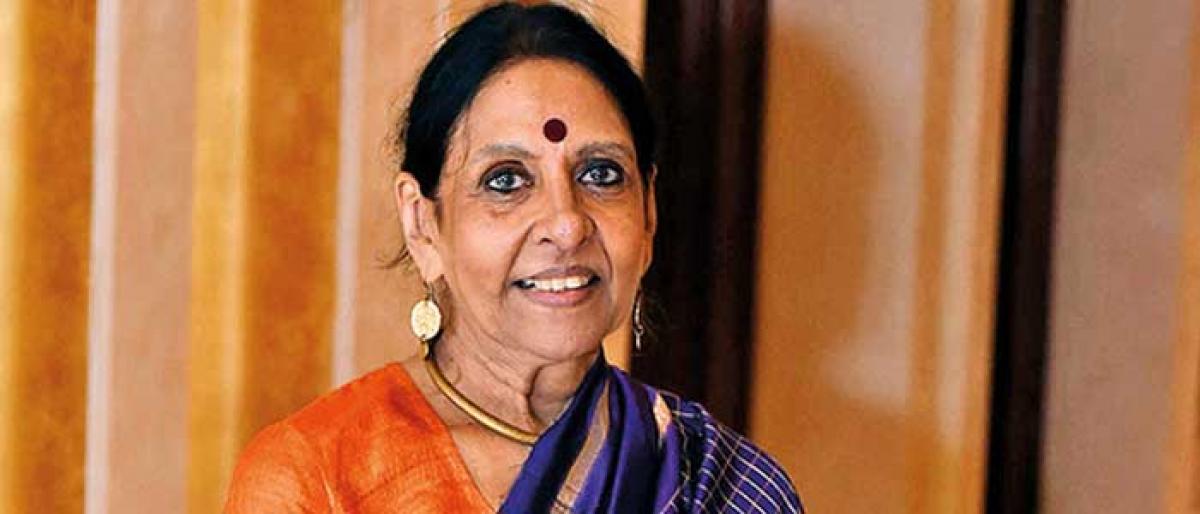Live
- SBI rescues sr citizen from `46L cyber fraud
- 12-yr-old dies of electrocution
- Installation of smart meters opposed
- State Cabinet expansion in focus as CM leaves for Delhi
- Need to reintroduce country’s forgotten pride: Bhagwat
- Pant shatters Iyer's IPL auction record, sold to Super Giants for Rs 27 cr
- Yuva Sangeetha Sammelanam held
- Dharani proves a bane for 25K families across State
- Reckless, Dangerous Arms Race
- Russia needs a peace deal as it is running out of soldiers
Just In

Former politician Jaya Jaitly in order to enable rural artisans and to promote Indian crafts founded Dastkari Haat Samiti in 1986.
Former politician Jaya Jaitly in order to enable rural artisans and to promote Indian crafts founded Dastkari Haat Samiti in 1986.
She has authored and published books on the crafts of Jammu, Kashmir and Ladakh, the Craft Traditions of India, Viswakarma’s Children, a socio-economic study of craftspeople, and Crafting Nature. A selection of her articles on politics, social issues, women, human rights, foreign affairs, etc. was compiled into a book titled ‘Podium on the Pavement’.
Excerpts:
What was the idea behind starting Dastkari Haat Samiti?
We began with creating a platform that was for craftspersons and run by them so that they could have the freedom to plan their own destinies, projects and programmes. This meant 2/3rds of the members must be craftspersons or their organisations and only 1/3 members could be non-craftspersons well-wishers, professionals who want to contribute to the sector, etc. It was built as an association rather than an NGO that is usually constituted of non-craftspersons.
You have founded DHS in 1986; after three decades what changes do you see in the field of handicrafts; India in particular and the world in general?
Handicrafts got a boost in India with the advent of globalisation because interestingly, governments and individuals worked on protecting them. Crafts became unique in a world of similar brands everywhere. Dilli Haat gave crafts marketing a big boost through visibility and opportunity for direct contacts.
Today a lot of designers have worked with craftspeople and pushed their quality levels up. Now crafts are at many venues and contexts so I believe as much as many may be suffering through loss of certain markets or demand for their skills, an equal number have risen in economic and social status.
India has the greatest and most number of living craft traditions in the world. We do not realise that enough and take pride in them at a national level as citizens.
How is the response to this year’s edition of Dastkari Haat Craft Bazaar?
Very good indeed. The craftspeople collectively crossed a turnover of Rs 6 crore in 15 days. The visitors constantly came to us to congratulate us for the great show and said now Dilli Haat is as it should be always. They loved the crafts and craftspeople and the demonstrations of skills were highly appreciated.
What are the other activities that are undertaken besides the craft bazaar?
We are doing visual research and documentation for the Google Art and Culture website, conducting and partnering an exhibition at the India Heritage Centre in Singapore from Dec 17- June 18; done an aesthetic and artistic upliftment of some rickshaws in Varanasi - hoping to find funding for replications at a larger level. We bring out publications. Our design training for individual crafts people goes on free of cost throughout the year, we offer workshops to schools, and create storybooks for children illustrated by traditional artists.
With the boom of the internet in the recent past, do you think it helped or will it help the artisans?
There is a good and bad side. The good is many websites now educate the world about Indian crafts. Possibilities have opened up for craftspeople to have their own websites, Facebook activities and use their smartphones for a lot of things. They search for designs and information on the internet too. It helps them contact customers all over the world and kids in their families have realised computer training can help their businesses.
The bad side is small folks selling online gets swallowed up by the very big fish like Amazon, Flipkart, AJio and other such giants. Secondly touching, feeling, draping and appreciating exclusivity and non-standardisation is the foundation of crafts marketing and purchasing. Online stores cannot offer that. Many fraudulent persons sell power loom as handloom and factory-made as handmade to unsuspecting internet shoppers, giving crafts a bad name.
Why do handicrafts take a backseat in our country while other countries give prominence to their crafts?
There are a plethora of reasons: Many urbanites prefer what is from abroad, we ignore our craft skills because we perhaps have so many, like it’s a visual glut. We are often not appreciative of what is Indian, we do not make an effort to immerse ourselves in our culture - there are so many reasons!
What are the new age challenges in promotion of handicrafts?
There are only opportunities, no challenges. The 'new age' loves environment-friendly stuff, going back to nature and unique aspects of different cultures - all these can be leveraged by those who work with Indian crafts and their development and promotion.
What is the all India impact of Dastkari based on current initiatives?
This is a question best asked of the craftspeople associated with us. Actually, our Facebook page has a lot of public responses. Personally, I hope we have helped craftspeople gain respect, better earnings and expanded their vision and capabilities.

© 2024 Hyderabad Media House Limited/The Hans India. All rights reserved. Powered by hocalwire.com







